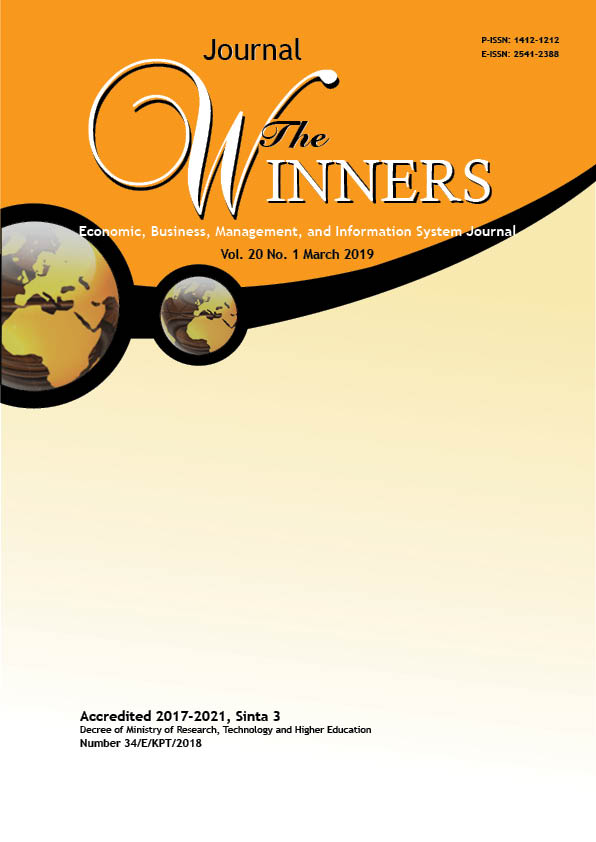Successful Implementation of Enterprise Resource Planning
DOI:
https://doi.org/10.21512/tw.v20i1.5359Keywords:
Enterprise Resource Planning, DeLone and McLean model, system quality, information quality, service qualityAbstract
The purpose of this research was to analyze factors that influence a successful implementation of Enterprise Resource Planning (ERP) at PT Agung Sedayu Group. Measuring the success of ERP implementation was needed to find out what success factors influence the implementation process. The DeLone and McLean success model was used as a measurement tool with employees who actively used the ERP system as respondents. The research method used was a descriptive quantitative method with questionnaires as data collection techniques with the indicators on DeLone and McLean model. Data taken from the questionnaire were 187 samples from 350 active user population systems at PT Agung Sedayu Group. Questionnaire data were processed using the SPSS application to test the validity and reliability; then linear regression analysis was performed to test the hypothesis. From the results of the research, it is known that all variables of system quality, information quality, service quality, usage, user satisfaction, and net benefits have an influence on the successful implementation of ERP at PT Agung Sedayu Group. The conclusion presents that the successful implementation of ERP is more influenced by user satisfaction supported by the level of use, system quality, information quality, and service quality.
References
Alianto, H., & Wijaya, S. F. (2013). Penerapan sistem ERP dalam membuat project feasibility, project status dan project monitoring pada perusahaan di bidang kontraktor. ComTech: Computer, Mathematics, and Engineering Applications, 4(2), 582-587. doi:10.21512/comtech.v4i2.2481.
Anardani, S., & Putera, A. R. (2018). Analisa perancangan sistem informasi berbasis enterprise resource planning pada CV Mitra Internusa Jaya Surabaya. Multitek Indonesia, 11(2), 80-85. doi:10.24269/mtkind.v11i2.706.
Brady, J. A., Monk, E. F., & Wagner, B. J. (2001). Concepts in enterprise resource planning. Canada: Course Technology Thomson Learning.
Caldeira, M. M., & Ward, J. M. (2002). Understanding the successful adoption and use of IS/IT in SMEs: An explanation from Portuguese manufacturing industries. Information Systems Journal 12(2), 121–152.
Irfani, M. H. (2015). ERP (Enterprise Resource Planning) dan aspek-aspek penting dalam penerapannya. Eksplora Informatika, 4(2), 105-114. https://doi.org/10.1257/aer.90.2.59.
Petter, S., DeLone, W., & McLean, E. (2008). Measuring information systems success: Models, dimensions, measures, and interrelationships. European Journal of Information Systems, 17(3), 236–263. https://doi.org/10.1057/ejis.2008.15.
Saputro, P. H., Budiyanto, A. D., & Santoso, A. J. (2016). Analisa kesuksesan e-government menggunakan success model’s Delone and M Clean (Studi kasus: Pemerintah kota Pekalongan). Seminar Nasional Teknologi Informasi dan Komunikasi 2016. Pekolongan, Indonesia. pp. 18–19.
Sekaran, U., & Bougie, R. (2009). Research method for business: A skill building approach (5th edition). United States: John Wiley & Sons Inc.
Setyo, D., & Rahmawati, D. A. (2015). Pengaruh kualitas informasi dan kualitas sistem informasi terhadap kepuasan serta kinerja pengguna sistem informasi. Jurnal Bisnis dan Ekonomi, 6(1),
–59. https://doi.org/10.1017/CBO9781107415324.004.
Simamora, B. H., Wicaksono, K. C., Toindo, H., & Rudi, R. (2015). Tingkat keberhasilan implementasi enterprise resources planning di BUMN sektor manufaktur di Indonesia. Binus Business Review, 6(2), 184-195. doi:10.21512/bbr.v6i2.968.
Wicaksono, A., Mulyo, H. H., & Riantono, I. E. (2015). Analisis dampak penerapan sistem ERP terhadap kinerja pengguna. Binus Business Review, 6(1), 25-34. doi:10.21512/bbr.v6i1.985.
Wijaya, S. F., & Alianto, H. (2012). Esensi dan penerapan ERP dalam Bisnis (Dilengkapi studi kasus aplikasi ERP dengan menggunakan metode OOAD). Yogyakarta: Graha Ilmu.
Wisudiawan, G. A. A. (2015). Analisis faktor kesuksesan sistem informasi menggunakan model Delone and McLean. Jurnal Ilmiah Teknologi Informasi Terapan, 2(1), 55–59.
Downloads
Published
How to Cite
Issue
Section
License
Authors who publish with this journal agree to the following terms:
a. Authors retain copyright and grant the journal right of first publication with the work simultaneously licensed under a Creative Commons Attribution License - Share Alike that allows others to share the work with an acknowledgment of the work's authorship and initial publication in this journal.
b. Authors are able to enter into separate, additional contractual arrangements for the non-exclusive distribution of the journal's published version of the work (e.g., post it to an institutional repository or publish it in a book), with an acknowledgment of its initial publication in this journal.
c. Authors are permitted and encouraged to post their work online (e.g., in institutional repositories or on their website) prior to and during the submission process, as it can lead to productive exchanges, as well as earlier and greater citation of published work.
USER RIGHTS
All articles published Open Access will be immediately and permanently free for everyone to read and download. We are continuously working with our author communities to select the best choice of license options, currently being defined for this journal as follows: Creative Commons Attribution-Share Alike (CC BY-SA)

















